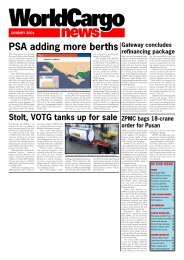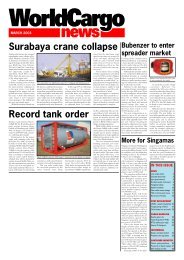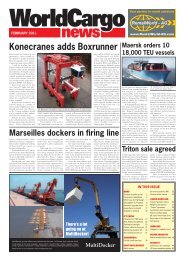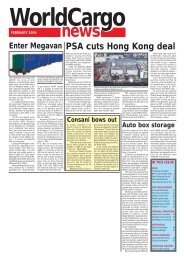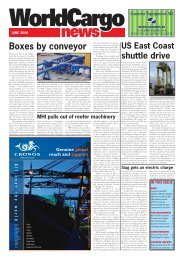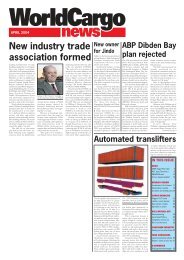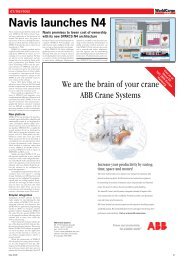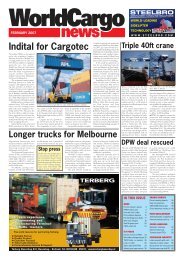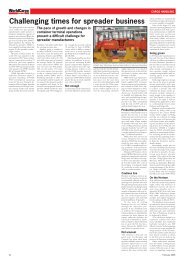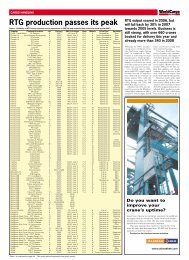WCN Dec Front page - WorldCargo News Online
WCN Dec Front page - WorldCargo News Online
WCN Dec Front page - WorldCargo News Online
Create successful ePaper yourself
Turn your PDF publications into a flip-book with our unique Google optimized e-Paper software.
<strong>WorldCargo</strong>newsTransfennica charts a new courseEarlier this year four large,chartered ro-ro newbuildingsentered service for Transfennicato serve its rapidlygrowing Hanko-Lübeck routeand the Helsinki-based operatoris set to receive more tonnagefollowing an order by itsmain shareholder, Spliethoff.Four 3000 lane-m ro-ros willbe built at the StoczniaSzczecinska Nowa shipyard inSzczecin, Poland.This yard previously built sixof Spliethoff’s advanced side loadingpaper carriers currently deployedon the North Atlanticroute using Rauma as the mainpaper export centre. The Dutchoperator recently ordered fourmore of these versatile, S-typesideport/lo-lo vessels, taking theyard’s output to 14 ships as the firstfour were built in Japan.Size mattersThe new ro-ros will be the largestin Transfennica’s long termcharter fleet. The line does notArtist’s impression of the new ships on order from Polandown vessels directly but has longterm relationships with variousshipowners whereby the ownersorder a ship to suit Transfennica’sspecifications in return for a longterm charter commitment.The latest agreement, however,differs considerably, in that theshipowner ordering the vessels onbehalf of Transfennica is also itsmajority shareholder with a 51 percent stake. This controlling interestwas sold last year by Transfennica’spaper manufacturingshareholders, who originallyformed the company to securetheir exports, to TransfennicaNederland BV, a Dutch-registeredcompany part which is part of theprivately-owned Spliethoff group.While Finncarriers claimedTransfennica, the move wasblocked by the government oncompetition grounds, thereby allowingSpliethoff to step in. TheDutch group’s initial shareholdingagreement includes an option toincrease its stake, which may wellhappen as the paper industry owners,UPM-Kymmene, M-real andMyllykoski Paper who each retaina seat on the main Board alongwith three Spliethoff directors,seek to concentrate more on corebusiness. The acquisition is seen bymany observers as a good solutionas it gives Transfennica access toSpliethoff’s different cargo carryingapproach. At the same time itprovides Spliethoff with Transfennica’sro-ro expertise.First for SpliethoffThe new vessels are Spliethoff ’sfirst true ro-ro vessels as it has alwaysconcentrated on lo-lo operations.But it has entered the projectwith an open mind and the shipswill provide a high container deckstow capability.The newbuildings are based onthe design of its latest generationvessels from the German Sietasshipyard, although significantlylarger at 205m Loa instead of153m Loa of these earlier ships.This generates some 3000 lanemof capacity, including the fixedinternal ramps, over four deck levels,although if the weather deckis taken out for container stowage,ro-ro capacity is reduced toaround 2600 lane-m. While thisappears disproportionate, as containerscannot be stowed underthe accommodation deckhouse asthere is no direct crane access, it ispossible for trailers or cassettes tobe parked there. Delivery of thefirst ship is scheduled for the endof 2005, with one newbuildingfollowing at four month intervals.Open to offersTransfennica stresses that no decisionshave yet to be made as towhere the newbuildings will bedeployed and that they are suitablefor all of their existing services.However, the very highweather deck container capacityof some 660 TEU in three tiers(the upper tier would have to beempty or lightly loaded units forstability requirements) would suitthe Hamina-Lübeck service.German operator Combisped(HHLA/LHG) has slot-charteredthe weather deck of the vesselscurrently serving this route exclusivelyfor containers. The ships callfirst at Lübeck’s Nordlandkai terminalto discharge ro-ro cargo andthen transfer to Container TerminalLübeck (CTL) to (un)load theweather deck.Market take-up of the Combispedservice has not been as highas forecast (<strong>WorldCargo</strong> <strong>News</strong>, August2003, p17). However, blocktrains linking Hamburg and CTLand Hamina and Moscow wouldfurnish a Moscow-Hamburg transittime of just five days, and thusmake the service more attractive.It is also worth noting that thenewbuildings are about the samesize as the four new chartered shipscurrently operating the Hanko-Lübeck service. They could wellreplace them and allow them tobe returned or sub-chartered.Interestingly, Transfennica admitsthat the vessels could carryStoraEnso’s SECU 95 tonne cassettesif these were ever to be introducedinto the Finnish paperexport chain (see p15). The shipsare specified with higher decksand a 200 tonne capacity sternramp, mainly to allow the carriageof rolling heavy cargoes, such aselectrical transformers and projectcargo. These features would alsoallow SECU boxes to be carriedon the main deck as well.Big but quickThe vessels break with Transfennica’soperational concept ofhaving relatively small vessels providinga frequent service. Theymean that it must now operaterelatively large ro-ros but still ona tight frequency basis, therebyplacing considerable pressure onport turnaround times.The rapid growth of theLübeck-Hanko service, mainly asa result of M-real (which also control’sHanko’s main stevedoringcompany) directing traffic throughthe port, has meant thatTransfennica has had to turn tothe open charter market, insteadof working directly through owners,to take two pairs of large roronewbuildings.FINLAND: SHIPPINGThe company is thus now accruingexperience on turninground vessels which, in terms oflane-m, are almost twice the capacityof the existing 13 vesselsforming the long term core fleet.This flexibility can be seenfrom the fact that on three sailingseach week, when the vessel dischargesits Lübeck cargo at Hanko,it sails to the Estonian port ofPaldiski (three hours sailing time),where it discharges further cargo,mainly trailers loaded in Lübeck,then back loads again mainly trailersfor Germany.The ship then returns toHanko where it loads the Finnishexports and sails for Lübeck onthe evening of the morning whenit first arrived in the Finnish port!While this shuttle service mayappear an expensive option, it hasproved increasingly popular fortrailer traffic between Germanyand Estonia.Navy to the rescueTwo of these new chartered ships,LONGSTONE and BEACHY HEAD, arefrom the AWSR consortiumwhich was established to constructand operate six ro-ro vessels undera Private Finance Initiativefrom the British government.Four of the vessels operate forthe Ministry of Defence whiletwo are allowed to operate commercially,provided that they areavailable to the MoD in the eventof an emergency.Transfennica claims that theships have fitted well into itsservice, despite features such asthe provision of a side door anddeck crane which it does notuse. Also the weather deck containerfittings are more widelyspaced than on a commercialvessel due to the requirement ofthe MoD that deck containersmust be accessible at sea. Thisallows them to be used forworkshops, stores, emergencyaccommodation, etc, but it doesnot maximise on available spacefor high density stowage.The ships entered service inspring this year and were followedby two 3000 lane-m Stenanewbuildings, STENA FORERUNNERand STENA FORECASTER, in Juneand October. These Chinese-builtvessels are based on Stena’s ForerunnerMark 2 series. Servicespeed is 22 knots, compared to the21 knots of the AWSR ro-ros.The latest Transfennica newbuildingswill also have a 22 knotservice speed in keeping with itspolicy of relatively high speeds. Allits current core 13 ships have servicespeeds of 20-21 knots. Thelarger ships cannot rely on beingslightly faster to compensate forhaving almost twice the capacityand they still have to provide thesame port turnaround times.While slower speed would bemore economical, Transfennicapoints out that as all its ships areIce Class 1A Super, including theBritish-flag AWSR ships. Hencea power level must be installed inexcess of what would normally berequired. As such, if the hull formis made finer, high service speedcan be maintained. ❏To the Finland stationVR Cargo has a long history oftransporting long, heavy and oversizedcargo to Russia and otherCIS countries. Oil rig equipment,farm machinery, etc usually enterFinland by sea from Europe or theUS, heading for Russia and theCentral Asian Republics. TheFinnish route is a natural one asthe goods are easily reloaded ontoRussian wagons in the Finnishports, says VR Cargo’s marketingmanager Janne Häyrinen.VR Cargo’s loading specialistscompile a loading sketch and astrength calculation of each specialtransport and these are sentto the MPS or October Railwayfor approval for the transport.Permits have been processedsignificantly quicker in the pastfew years, so the overall transporttime is also much shorter. Loadingsketches are drafted with theAutoCad program, so the authorisationprocess should be evenfaster once electronic data transferis possible. ❏14<strong>Dec</strong>ember 2003



